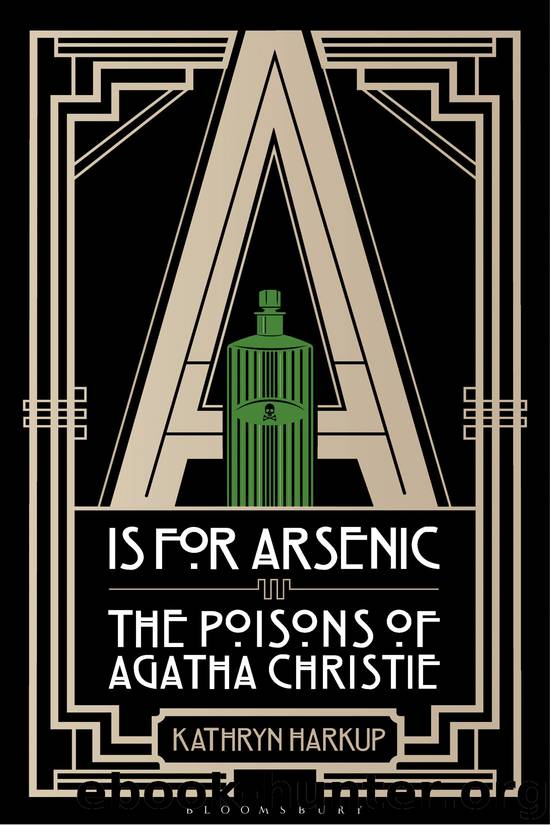A is For Arsenic by Kathryn Harkup

Author:Kathryn Harkup
Language: eng
Format: epub
Publisher: Bloomsbury
Three Act Tragedy
Mr Babbington was peering across the room with amiable short-sighted eyes. He took a sip of his cocktail and choked a little. He was unused to cocktails, thought Mr Satterthwaite amusedly … Mr Babbington took another determined mouthful …
‘Look,’ said Egg’s voice. ‘Mr Babbington is ill.’
Agatha Christie, Three Act Tragedy
AGATHA Christie’s 1935 novel Three Act Tragedy (entitled Murder in Three Acts in the United States) is the only one of her novels to use nicotine as the means of murder. The three victims – a mild-mannered vicar, an eminent doctor and a patient at a sanatorium – appear to have nothing in common. The first death is, after some consideration, initially attributed to natural causes; the second occurs under similar circumstances, with the victim displaying almost identical symptoms before dying – after which it is realised that there’s a murderer about. The third is carried out to silence a witness. All the victims are dispatched by a lethal natural product, nicotine. Among the suspects are an actor, a dressmaker, a playwright and even a butler, none of whom seem to have a motive. Fortunately, Hercule Poirot is on hand to sort through the red herrings and reveal the culprit.
Most people are aware that nicotine is dangerous. It is indirectly responsible for thousands of deaths annually through smoking; nicotine causes the addiction, but it is other compounds from tobacco smoke that usually kill smokers. Pure nicotine, however, is highly toxic in its own right, and has been the cause of many fatalities; it has rarely been used in murder, though. This is surprising given its ready availability, but perhaps because it is so commonplace we struggle to believe that such an everyday substance could be used to kill.
The nicotine story
At room temperature, nicotine is a clear colourless liquid. It mixes completely with both water and alcohol and has a strong, distinctive taste. When exposed to air it turns brown, almost whisky-coloured. The pure liquid gives off a characteristic tobacco-like smell.
The chemical is an alkaloid found in plants of the genus Nicotiana. These are part of the family Solanaceae (which we met on page here) that includes plants such as deadly nightshade, the tomato and the potato. Nicotine actually occurs in all Solanaceae, but it is Nicotiana that has the highest concentrations of the compound. There are many species in the genus, which is native to the Americas, Australia, south-west Africa and the South Pacific, though they are commonly grown in gardens across Europe for ornamental purposes. Nicotiana tabacum is the species grown commercially, with tobacco products derived from the dried leaves of the plant.60
Nicotine can be absorbed through the skin, the lungs and the gastrointestinal tract, hence the wide variety of tobacco products that can be smoked, chewed, inhaled or attached to the skin (it is nicotine itself that is incorporated into patches, gum and e-cigarettes as the key ingredient used to help break the addiction to smoking).
Tobacco has been smoked, chewed and snorted for hundreds if not thousands of years in the Americas, and was first brought to Europe in 1528 by returning Spaniards.
Download
This site does not store any files on its server. We only index and link to content provided by other sites. Please contact the content providers to delete copyright contents if any and email us, we'll remove relevant links or contents immediately.
4 3 2 1: A Novel by Paul Auster(11035)
The handmaid's tale by Margaret Atwood(6838)
Giovanni's Room by James Baldwin(5873)
Big Magic: Creative Living Beyond Fear by Elizabeth Gilbert(4719)
Asking the Right Questions: A Guide to Critical Thinking by M. Neil Browne & Stuart M. Keeley(4567)
On Writing A Memoir of the Craft by Stephen King(4206)
Ego Is the Enemy by Ryan Holiday(3982)
Ken Follett - World without end by Ken Follett(3968)
The Body: A Guide for Occupants by Bill Bryson(3791)
Bluets by Maggie Nelson(3705)
Adulting by Kelly Williams Brown(3663)
Guilty Pleasures by Laurell K Hamilton(3578)
Eat That Frog! by Brian Tracy(3509)
White Noise - A Novel by Don DeLillo(3430)
The Poetry of Pablo Neruda by Pablo Neruda(3358)
Alive: The Story of the Andes Survivors by Piers Paul Read(3304)
The Bookshop by Penelope Fitzgerald(3222)
The Book of Joy by Dalai Lama(3212)
Fingerprints of the Gods by Graham Hancock(3207)
